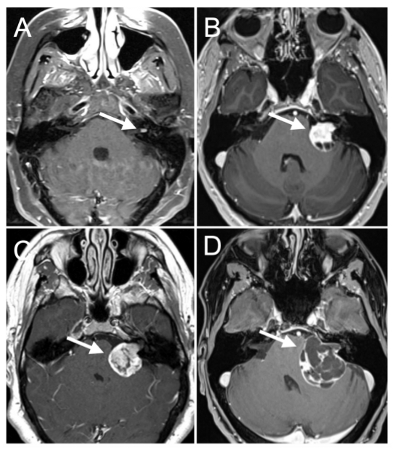Investigations
1st investigations to order
audiogram
Test
Any asymmetrical hearing loss points to sensorineural or retrocochlear aetiology.
Abnormalities are often discovered on routine testing, and imaging should follow.
Definitions of asymmetrical sensorineural hearing loss vary; however, recent guidelines indicate that interaural differences >10 decibel hearing level (dB HL) in 2 contiguous frequencies, or 15 dB HL in a single frequency, warrant MRI.[45] Similarly, differences >20% in word recognition score between ears warrant head MRI.
Result
sensorineural/retrocochlear hearing loss
T1-weighted MRI using gadolinium-based contrast
Test
This is the standard confirmatory test. [Figure caption and citation for the preceding image starts]: Contrast-enhanced T1-weighted axial MRI studies demonstrating various sizes of left-sided sporadic vestibular schwannoma. (A) small intracanalicular vestibular schwannoma; (B-C) medium-sized vestibular schwannomas; (D) large cystic vestibular schwannomaFrom the personal collection of Michael J. Link and Matthew L. Carlson, Mayo Clinic, Rochester, MN; used with permission [Citation ends].
Result
avidly enhancing mass within the internal auditory canal, with or without extension into the cerebellopontine angle, strongly suggests diagnosis of vestibular schwannoma
contrast-enhanced head CT
Test
Head MRI represents the diagnostic gold standard, and head CT should only be pursued when head MRI is not available or contraindicated. Notably, contrast-enhanced head CT may not detect vestibular schwannomas that are <1 cm in the cerebellopontine angle. Indirect signs such as bony widening of the internal auditory canal may be seen, which raise suspicion for vestibular schwannoma.
In addition, CT potentially has a complementary role by providing useful preoperative information about relevant surgical anatomy of the skull base, especially the petrous bone.[13]
Result
internal acoustic meatus enlarged compared with other side on bone windows; tumours >1 cm in the cerebellopontine angle may be detected using contrast-enhanced head CT
Investigations to consider
auditory brainstem reflexes
Test
Although historically used, auditory brainstem reflexes should not be used regularly to screen for the presence of vestibular schwannoma given limited sensitivity.
Preoperative and intra-operative auditory brainstem reflexes may be useful to prognosticate and carry out successful hearing preservation surgery in some cases.
Result
increasing latency and diminished amplitudes of waves I and V are classically seen in cases of vestibular schwannoma
Use of this content is subject to our disclaimer